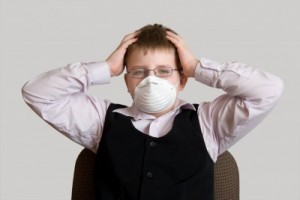Indoor Air Quality
 Inadequate ventilation is caused by pollution sources that release gases and particles into the air resulting in indoor pollution. Proper ventilation will allow enough of the outdoor air to dilute emissions. High temperature and humidity levels can also increase concentrations of air pollutants. If too little outdoor air enters a home, pollutants can accumulate to levels that can pose health and comfort problems. Unless they are built with special mechanical means of ventilation, homes that are designed and constructed to minimize the amount of outdoor air that can “leak” into and out of the home may have higher pollutant levels than other homes. Unfortunately, for some, weather conditions can drastically reduce the amount of outdoor air that enters a home.
Inadequate ventilation is caused by pollution sources that release gases and particles into the air resulting in indoor pollution. Proper ventilation will allow enough of the outdoor air to dilute emissions. High temperature and humidity levels can also increase concentrations of air pollutants. If too little outdoor air enters a home, pollutants can accumulate to levels that can pose health and comfort problems. Unless they are built with special mechanical means of ventilation, homes that are designed and constructed to minimize the amount of outdoor air that can “leak” into and out of the home may have higher pollutant levels than other homes. Unfortunately, for some, weather conditions can drastically reduce the amount of outdoor air that enters a home.
There are many sources of indoor air pollution in any home. These include combustion sources such as oil, gas, kerosene, coal, wood, and tobacco products; building materials and furnishings as diverse as deteriorated, asbestos-containing insulation, wet or damp carpet, and cabinetry or furniture made of certain pressed wood products; products for household cleaning and maintenance, personal care, or hobbies; central heating and cooling systems and humidification devices; and outdoor sources such as radon, pesticides, and outdoor air pollution. The list is long and ominous but many can be easily disposed of and many are not even seen in most homes.
The relative importance of any single source depends on how much of a given pollutant it emits and how hazardous those emissions are. In some cases, factors such as how old the source is and whether it is properly maintained are significant. For example, an improperly adjusted gas stove can emit significantly more carbon monoxide than one that is properly adjusted.
Some sources, such as building materials, furnishings, and household products like air fresheners, release pollutants more or less continuously. Other sources, related to activities carried out in the home, release pollutants intermittently. These include smoking, the use of unvented or malfunctioning stoves, furnaces, or space heaters, the use of solvents in cleaning and hobby activities, the use of paint strippers in redecorating activities, and the use of cleaning products and pesticides in house-keeping. High pollutant concentrations can remain in the air for long periods after some of these activities.
Outdoor air enters and leaves a house by: infiltration, natural ventilation, and mechanical ventilation. In a process known as infiltration, outdoor air flows into the house through openings, joints, and cracks in walls, floors, and ceilings, and around windows and doors. In natural ventilation, air moves through opened windows and doors. Air movement associated with infiltration and natural ventilation is caused by air temperature differences between indoors and outdoors and by wind. Finally, there are a number of mechanical ventilation devices, from outdoor-vented fans that intermittently remove air from a single room, such as bathrooms and kitchen, to air handling systems that use fans and duct work to continuously remove indoor air and distribute filtered and conditioned outdoor air to strategic points throughout the house. The rate at which outdoor air replaces indoor air is described as the air exchange rate. When there is little infiltration, natural ventilation, or mechanical ventilation, the air exchange rate is low and pollutant levels can increase.
Health effects from indoor air pollutants may be experienced soon after exposure or, possibly, years later. The EPA’s Indoor Environments is responsible for conducting research and educating the public about indoor environmental issues, including health risks and the means by which human exposures can be reduced. The Indoor Environments Department educates the public about health risks associated with a variety of indoor environmental pollutants and sources of pollution, including radon, mold and moisture, secondhand smoke, indoor wood smoke, and environmental asthma triggers.
Source: “Indoor Air Quality: An Introduction to IAQ.” EPA. Environmental Protection Agency, Web. 07 Apr. 2013.
Call us today to view our new home plans: 713-539-0048 – Sign up for our New Home Buying Tips
Visit our website: https://fairmontcustomhomes.com/
View Our Communities – View our available new home floor plans – View our photo gallery
Follow Us: Facebook – Twitter – YouTube – LinkedIn – Google Plus


Sorry, the comment form is closed at this time.